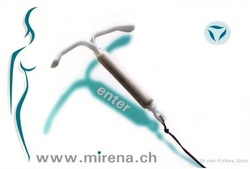
Long acting reversible contraception
For women whose family is not yet complete, but want to get pregnant in the future. The Mirena IUS (intrauterine system) may be what they would chose to manage their heavy periods.
Twenty-five years ago 60% of women had hysterectomy within 5 years of presentation, and 10 years ago 20% of women still had a hysterectomy within 2years.
The Mirena was first introduced in the 1970s to increase the efficacy of contraception, because of the hormones it contains (Levenogestrel) it was found to decrease the heaviness and the number of days of menstrual loss.
It works by releasing low dose hormones into the uterus, and provides effective treatment for women who need to treat their heavy menstrual bleeding and control their fertility at the same time
It is a small T-shaped plastic device that sits inside the womb. Evidence suggests it reduces heavy menstrual bleeding in 90% of women and 20% of women who use it will stop having periods altogether. It takes a little while to start working and the full benefits may not be noticed for 3-6 months.
Before women have the Mirena inserted it is important that a detailed history is taken and examination to ensure that the Mirena would be suitable.
It is contraindicated if women are pregnant or have current pelvic inflammatory disease.
If there are large fibroids that distort the cavity of the womb it may be unsuitable as expulsion rates may be up to 20% in this group of women, against a background expulsion rate of about 0.5%. For women with small fibroids less than 3cm it may be suitable. Expulsion usually happens within the first 3 months of insertion, most often during menstruation. The advice is to have it checked within the first few months of insertion to make sure it is still there.
The commonest reason for discontinuation of the Mirena IUS is continued menstrual irregularity at 5 years up to 60% of women have been known to have the device removed. The rate of discontinuation may depend on how women were counseled before insertion. Women are however encouraged to persevere for at least 6 months to allow the system to “bed in.”
Other undesirable side effects include:
Breast tenderness in a minority of women
Changes in mood and libido: though there have been documented reports of loss of libido and mood this only occurs in a very minor group of women. It is unlikely to occur
Depression: reports of depression are uncommon. It is probably best avoided with a proven history of depression and if depression does occur it can easily be removed.
Acne and skin changes
Headaches and migraines: this only happens in a minority of women
There is no evidence that it causes weight gain
Once removed fertility returns quite quickly between 80-96% of women will get pregnant within a year of removal of Mirena
On the contraceptive front it is as effective as being sterilized with a failure rate of less than 10 in 1000 over 5 years.
Most often the Mirena is inserted in the outpatients or in the family planning clinic. Its efficacy lasts for up to 5 years after which it should be changed.








 RSS Feed
RSS Feed